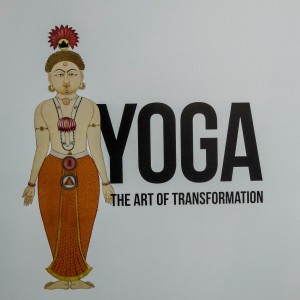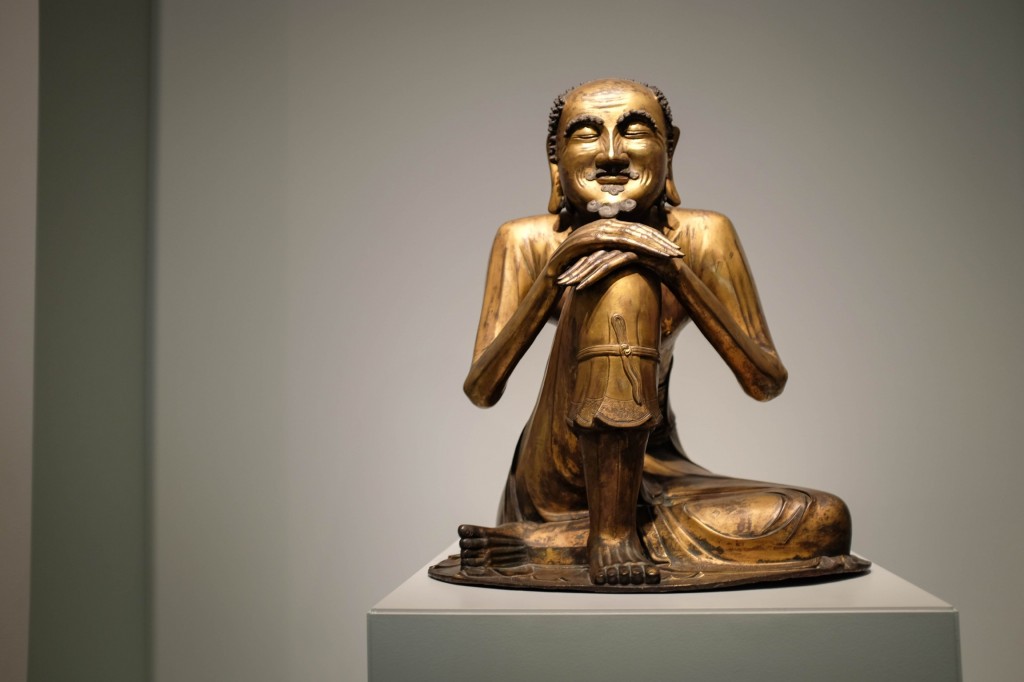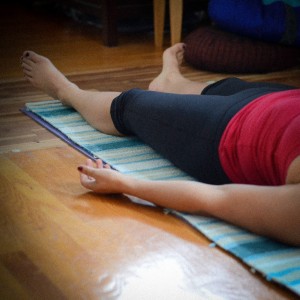Blog
Yoga, Art, and Transformation
 Yesterday, my sweetheart and I put off our daily practice until evening and headed to the city to check out the latest arrival to the Asian Art Museum “Yoga: The Art of Transformation.” As expected, it was truly inspirational. I haven’t any photos of the pieces on display in the three galleries as photography of any kind is not allowed. However I can attest that a visit, especially for you yogis and yoginis in the Bay Area, is well worth the drive.
Yesterday, my sweetheart and I put off our daily practice until evening and headed to the city to check out the latest arrival to the Asian Art Museum “Yoga: The Art of Transformation.” As expected, it was truly inspirational. I haven’t any photos of the pieces on display in the three galleries as photography of any kind is not allowed. However I can attest that a visit, especially for you yogis and yoginis in the Bay Area, is well worth the drive.
I have been realizing that years and years of study may only skim the top of all there is to learn about yogic history and philosophy. At my rate, the level of understanding comes even slower… or so it seems. In touring the exhibit, I was pleasantly surprised at how much I had come to know. Perhaps there is some sort of transformation happening after all.
My advice to those who venture to the city for this exhibit is to also check out the gallery on the third floor. There are a whole lot of cool pieces to check out. One of my favorites is this statue of “The Buddha Shakyamuni as an ascetic.” I love his blissful smile and relaxed posture. It made me want to head out to find a tree to sit under and meditate for a bit.
Falling out and Falling IN
One of the key components of Ashtanga yoga involves keeping our eyes focused on a particular gazing point or “dristi.” This one-pointed focus is designed to pull your attention off of the world around you thereby assisting you in focusing within. I have experienced great difficulty in keeping my attention off of my surroundings. This is primarily due to my “falling out” of the pose when I let my gaze move from the wall to the tip of my nose.
In those few moments where I have successfully kept my focus on the prescribed point of focus has lead to some interesting observations. For one, when your eyes aren’t tethering you upright in space (whether your forward folding or upright, symmetrical in space or revolved) you must rely on your abdominal muscles to find balance. Another thing I’ve noticed is a reduction in pushing or pulling myself further into any given pose. I think this is because you can’t quite tell how far into the pose you are; you’re too focused on trying not to tip over.
 Even though I have experienced the benefits, I still find it a difficult task. Perhaps this is because breathing properly, with bandhas engaged, the diaphragm moving up and down, and air actually entering my lungs takes a insurmountable amount of energy. And then there is the asana: the posture, alignment, entry, exit, etcetera, etcetera. It’s endless. It’s hard. And still…
Even though I have experienced the benefits, I still find it a difficult task. Perhaps this is because breathing properly, with bandhas engaged, the diaphragm moving up and down, and air actually entering my lungs takes a insurmountable amount of energy. And then there is the asana: the posture, alignment, entry, exit, etcetera, etcetera. It’s endless. It’s hard. And still…
When my practice is done, I am left completely at ease. For a moment or two, I am able to “fall IN” and just be. That, my dear friends, is good.
Push or Pull?
Yesterday, my teacher posted an article titled “Reasons Your Ashtanga Teacher May Not Be Giving You More Poses.” Since I have all the poses I need right now, I did not open it up right away. Later in the morning, I clicked to the article for all the articles she refers to us generally have some helpful bit of information for me to glean. While reading, I pretty much nodded my head as went down the list…until I came upon the item about pushing too hard. I paused, remembering a conversation that occurred during Monday’s Mysore practice.
T: You aren’t pushing are you, Julie?
M: Pushing?
T: Yeah, pushing?
M: My leg?
T: No. You?
Giggles were heard coming from a nearby mat or two. My yogini friends who know my long standing endurance athlete tendency to push aggressively towards any and all goals. Honestly, in this instance, I didn’t think I was pushing – or pulling for that matter. But when she told me to soften I felt myself relax right onto my exended leg in Janu Sirsasana to such an extent that I could easily grasp the forearm of my outstretched arm. My whole body oo-d “Ahhh” as my teacher assisted me in the magical way she does.
I was still a little dumbstruck when she walked away to assist the next person. I moved on with my practice, trying to be mindful of not pushing yet careful to stay engaged (physically and mentally) where appropriate. Since I am still in a situation where I must to rely on my home practice to maintain a six-day-a-week practice, I need to learn to recognize when I am being too aggressive. It’s funny – because I spent much of my marathoning days racing hard to a point but never quite pushing hard enough to hit my goal.
As I maintain my six-day-a-week practice AND, at the same time, train to build up to a 4 day backpacking trek in the Grand Canyon, this distinction will be valuable on the mat, on the hiking trail, and in life in general. Quite frankly, I think it’s a good lesson for all.
To teach or not to teach?
This is not really the question. Not the real question, that is. However…
I have to admit, I’ve been seriously questioning my desire to become a yoga teacher. In a conversation just the other day I insisted, “There are so many yoga teachers already… and what have I got to add to the mix?” I asked. Then, I answered, “Nothing. I haven’t got anything to add that isn’t already fulfilling the needs of our community.” He tried to tell me I was wrong but quickly gave up the fight and just listened. That’s all I needed at the moment: a sounding board for my self-doubt and insecurity.
I am guessing that self-doubt, to some extent, is normal. Isn’t it? I mean, this isn’t the first time I’ve felt that my offering was of little to no value to others. On prior occasions, I was 110% off in my self-evaluation. If I had ignored my fears, and abandoned my plans, many would have lost out on account of my deep-rooted fear of not being good enough. I think this is what you would call a samskara, and probably one of my biggest ones.
On all the occasions where the perceived message was one of not-good-enough, the person on the other end always seemed to be asking for more. Although I cannot remember each instance, there have been MANY, I now wonder if I got it all wrong. What if their asking for more wasn’t that my offering wasn’t good enough but, instead, so good that they wanted more of it?
Moreover, how would it be different if my approach to giving wasn’t so tied up in receiving a response of gratitude? How would it be if I could just give without expecting something in return? This concept is indeed different than how we (I) have been brought up where, right from the start, we are taught to say “thank you” for the gifts receive. Don’t get me wrong. Gratitude is a good thing. I’m simply suggesting that the expectation of “Thank you for dinner, Mom. It is delicious,” can set one up for disappointment and invalidation when preoccupation interferes with the message being delivered – even if the recipient truly was appreciative.
Which brings me back to my offering and teaching… Read More
practicing compassion in the face of distraction
When I last wrote about my home practice, I failed to mention the fact the extent that my home practice is littered with interruptions. These interruptions, or momentary departures from my practice, have been a source of great frustration for me as they involve my teenage son waking, staying conscious, and actually staying aroused enough to function and get himself ready for school. Even on days when it is not my turn to drive the carpool, I do not feel able to leave for the studio until he has managed to get himself into the shower.
This week, his studies have kept him up exceptionally late – in spite of the addition of tutoring and organizational coaching. Last night he was up past midnight and still had not finished his assignments. It is no wonder that he cannot manage to pull himself from his slumbers. The poor guy is exhausted.
Meanwhile, I am wide awake and well into my practice by the time his first alarm sounds. This alarm not only blares in the rudest decibel but also brutally shakes the bed. It is not how I would want to wake up but it seems that even this does not always manage to stir him from his astral travels. This is where I come in. I turn on his light and try to engage him in conversation.
Then I return to my mat and resume my practice. By the time the second alarm sounds, my son has returned to a deep sleep. I listen, noting that the alarm gets turned off, and continue my practice. About 5 minutes later, when there are no signs of life outside of my room, I holler for him to get in the shower. If there is a verbal response, I stay on my mat. If not, I leave my mat and, while trying to maintain some sort of compassion and patience, wake him again. I am not always successful at this. And by successful, I mean compassionate and patient. Often times, I admit, I am downright resentful. But I try.
This past week, I have made a more conscious effort to temper my tendency towards resentfulness — remembering that my head hits the pillow MANY hours before my son’s does. Instead, I try to own this role as more of a motherly responsibility to which I am blessed with rather than burdened with. In terms of my practice, I am finding that this change in attitude serves me well in keeping my nervous system calm in much the same way as the tristana creates a space for me to be more focused on being grounded rather than the little aches and pains that reside in my body. I try to allow these distractions be more like the vinyasas connecting the postures than this nuisance which rips me out of the calm I have spent my morning creating – much like the sonic boom alarm clock I got my son for Christmas. And when I think about that, I figure it’s the least I can do.
Maybe it is a calling for me: to surrender to serve. Today, it is my son. Four years from now, it will be something or someone else. Or perhaps not.
